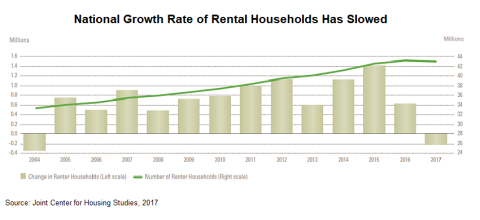The recent annual report on rental housing from Harvard University's Joint Center for Housing Studies (JCHS) has found that although the national demand for rental housing has decreased slightly overall, there is still significant need for housing affordable to low-income renters.

The number of U.S. rental households grew dramatically over the last decade, due in large part to the effects of the housing crash. Although the construction of rental housing increased during this time, the majority of new stock has been targeted towards high-income households, with fewer new affordable options for an increasing number of low-income renters. The report found that 11.0 million renter households are severely cost-burdened, paying more than 50% of their income towards housing costs. In Vermont, about 17,800 rental households (25% of renters) are severely cost-burdened, according to data from the U.S. Census Bureau.
The growth rate of renter households has slowed in 2016 and 2017. While this is a welcome sign that more households are now able to pursue homeownership, the Joint Center for Housing Studies predicts that renter households will account for roughly one third of future household growth. They write that the “new normal” is that almost half of renter households will continue to be cost-burdened.
The report noted the need for an increase in subsidies for lower-income households and emphasized the importance of programs like the Low Income Housing Tax Credit in stimulating development of affordable rental housing.
